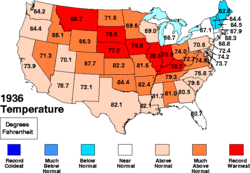Temperature
Overall

| Event [3] | Measurement | Date | Location |
|---|---|---|---|
| Highest Temperature | 115 °F (46.1 °C) | July 29, 1917 | Beardsley |
| Lowest Temperature | −60 °F (−51.1 °C) | February 2, 1996 | Tower |
| Largest single-day change | 72 °F (40 °C) | February 2, 1970 | Nett Lake [4] |
By month
| Climate data for Minnesota | |||||||||||||
|---|---|---|---|---|---|---|---|---|---|---|---|---|---|
| Month | Jan | Feb | Mar | Apr | May | Jun | Jul | Aug | Sep | Oct | Nov | Dec | Year |
| Record high °F (°C) | 69 (21) | 76 (24) | 88 (31) | 101 (38) | 112 (44) | 110 (43) | 115 (46) | 110 (43) | 111 (44) | 98 (37) | 84 (29) | 74 (23) | 115 (46) |
| Record low °F (°C) | −57 (−49) | −60 (−51) | −50 (−46) | −22 (−30) | 0 (−18) | 15 (−9) | 24 (−4) | 12 (−11) | 10 (−12) | −16 (−27) | −47 (−44) | −57 (−49) | −60 (−51) |
| [ citation needed ] | |||||||||||||
| Event [1] | Measurement | Date | Location |
|---|---|---|---|
| January | |||
| Highest Temperature | 69 °F (20.6 °C) | January 24, 1981 | Montevideo |
| Lowest Temperature | −57 °F (−49.4 °C) | January 20, 1869 January 24, 1904 January 20, 1996 | Embarrass Cohasset Tower |
| February | |||
| Highest Temperature | 76 °F (24.4 °C) | February 26, 1896 | Pleasant Mound |
| Lowest Temperature | −60 °F (−51.1 °C) | February 2, 1996 | Tower |
| March | |||
| Highest Temperature | 88 °F (31.1 °C) | March 23, 1910 | Montevideo |
| Lowest Temperature | −50 °F (−45.6 °C) | March 2, 1897 | Pine City Cohasset |
| April | |||
| Highest Temperature | 101 °F (38.3 °C) | April 22, 1980 | Hawley |
| Lowest Temperature | −22 °F (−30 °C) | April 6, 1979 April 6, 1982 | Karlstad Tower |
| May | |||
| Highest Temperature | 112 °F (44.4 °C) | May 31, 1934 | Maple Plain |
| Lowest Temperature | 0 °F (−17.8 °C) | May 9, 1916 | Grand Rapids |
| June | |||
| Highest Temperature | 110 °F (43.3 °C) | June 29, 1931 June 24, 1988 | Canby Browns Valley |
| Lowest Temperature | 15 °F (−9.4 °C) | June 1, 1964 | Bigfork |
| July | |||
| Highest Temperature | 115 °F (46.1 °C) | July 29, 1917 | Beardsley |
| Lowest Temperature | 24 °F (−4.4 °C) | July 7, 1997 and July 13, 2009 | Tower and Kelliher |
| August | |||
| Highest Temperature | 110 °F (43.3 °C) | August 10, 1947 August 1, 1988 | Beardsley Montevideo Madison |
| Lowest Temperature | 12 °F (−11.1 °C) | August 23, 1936 | Tower |
| September | |||
| Highest Temperature | 111 °F (43.9 °C) | September 11, 1931 | Beardsley |
| Lowest Temperature | 10 °F (−12.2 °C) | September 30, 1930 September 22, 1974 | Big Falls Thorhult |
| October | |||
| Highest Temperature | 98 °F (36.7 °C) | October 5, 1963 | Beardsley |
| Lowest Temperature | −16 °F (−26.7 °C) | October 26, 1936 | Roseau |
| November | |||
| Highest Temperature | 84 °F (28.9 °C) | November 1, 1950 November 4, 2020 | Winona Granite Falls |
| Lowest Temperature | −47 °F (−43.9 °C) | November 25, 1945 | Pine City |
| December | |||
| Highest Temperature | 74 °F (23.3 °C) | December 9, 1939 | Wheaton |
| Lowest Temperature | −57 °F (−49.4 °C) | December 31, 1898 | Pine City |



